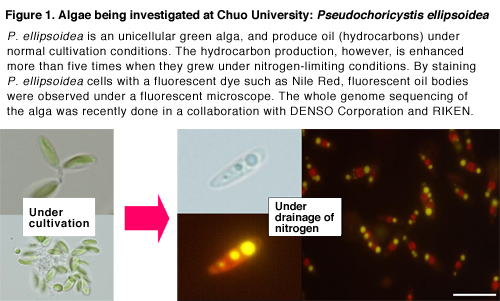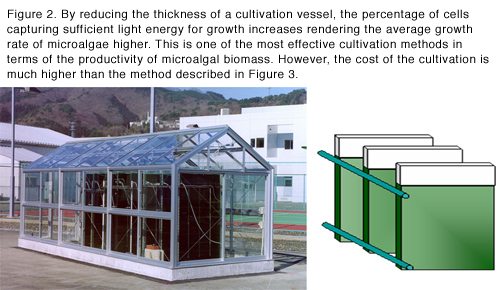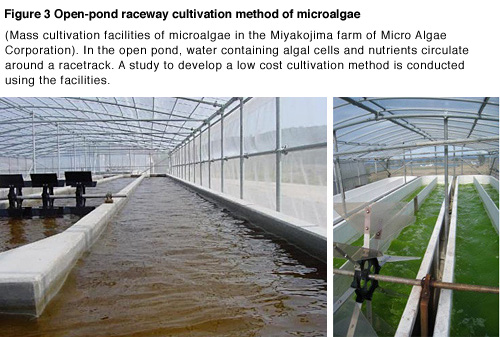Top>Research>Bio-fuel production in algae —Towards its commercialization—
 Index
Index

Shigeaki Harayama [Profile]
Education Cource
Bio-fuel production in algae
—Towards its commercialization—
Shigeaki Harayama
Professor of Microbiology, Faculty of Science and Engineering, Chuo University
It has been a long time since the idea of producing bio-fuel from algal biomass was born (1). Such idea came into the light again in the United States of America (USA) (2), and soon propagated in Japan. A subsequent boom of algal fuel researches seemed to be triggered by the State of the Union Address by President George W. Bush in 2007, which mandated the use of energy other than fossil fuel (3). Since then, the number of start-up companies investigating the production of algal fuel is rapidly increasing in the USA.
The readers of this article may have either of two different opinions on the algal fuel. One may regards it as a dream technology, while the other as a dreamy story. Perhaps, the reality lies in-between: algal fuel is currently not commercially feasible, but it will be commercially available in near future after the advent of new technologies.
- 1. (1) Bio-mass = The amount of living matter, or the amount of organic compounds in living matter which can be used as a energy source
- 2. (2) NEDO overseas report No.1026, 2008

- 3. (3) Renewable energy: The term "renewable energy" is misleading, and not used in this article.
What are algae?
Algae are aquatic oxygenic phototrophs (4). The first oxygenic phototroph, the ancestor of extant Cyanobacteria (blue-green algae), evolved about 3 billion years ago. Cyanobacteria are a group of bacteria lacking cell nucleus. During their evolution, a cyanobacterium cell took up residence within an eukaryotic cell (cell containing a nucleus), and became the origin of today's chloroplast. Some descendents of the first eukaryotic phototroph were again engulfed by other eukaryotes. Such secondary engulfment has occurred several times during the evolution giving rise to different groups of algae. Thus, the term "alga" does not represent a taxonomic category, but comprises a diverse group of phototrophs including both prokaryotes (Cyanobacteria) and eukaryotes with polyphyletic origins (e.g. red algae, brown algae, and green algae). All the land plants evolved from an ancestor of the green algae (5).
In spite of independent evolutionary origins, all the algae share common characteristics as being aquatic phototrophs, and thus the term "alga" is still used for convenience even in scientists involved in photosynthesis or aquaculture researches. For non-scientists, the grouping of the Wakame and Asakusanori seaweeds, which are popular Japanese foods, into the same category (algae) is more natural than the natural classification of these two seaweeds into two distant taxonomic groups, namely brown and red algae.
Many algae are unicellular (hereafter, unicellular algae are referred to as microalgae). Among them, some grow rapidly, and are easy to cultivate. Such algae often belong to either Cyanobacteria or green algae, and are preferred organisms for the production of bio-fuels (Figure 1). Researches are also conducted to utilize large algae (seaweeds) belonging to red and brown algae as biomass resources.

- 1. (4) Some cyanobacteria are tolerant to desiccation, and can thrive on land. Photosynthetic organisms that do not generate oxygen (photosynthetic bacteria) are not classified into algae.
- 2. (5) Several theories on the algal evolution exist, one being found at < http://bsj.or.jp/topics/01/hatena.html>.

What is biofuel?
The main biofuels include bioethanol and biodiesel.
Bioethanol
Bioethanol is mainly produced from sugarcane and corn. Sugars in sugarcane are transformed to ethanol by yeast. The starch in the corn cannot be decomposed by the yeast. So, enzymes such as amylase are used to decompose the starch to generate glucose, which is subsequently transformed to ethanol by yeast. It was found that some algae contain approximately 30% (w/w) of starch, and they are candidates for a source of bioethanol. Besides the starch, cellulose can be a source of bioethanol: cellulose is transformed by cellulose to glucose which is fermented by yeast to ethanol. However, major challenges still exist for the production of cellulosic ethanol.

Bioethanol is mainly used as transport fuel. Studies are also conducted on the production of butanol or propanol and the use of them as fuel and raw materials for value-added chemicals.
Biodiesel
Biodiesel refers to fuel for diesel engine, and produced by methyl-esterification of fatty acids, major components of biogenic oil, to lower their boiling points. In Europe, the biodiesel is produced from canola oil, sunflower oil, used cooking oil, and animal fat, and available at many gas stations. Currently, the quality of the biodiesel is not constant due to the difference in the composition of fatty acids in the raw materials.
Methane
Methane gas, generated by the methane fermentation process, can also be used as fuel. However, due to its purity and cost, this fuel should be considered merely as a useful by-product of wastewater treatment, and not as a cost-effective fuel production technology.
Why are the microalgae attracting attention?
Microalgae are considered to be attractive source for energy by the following reasons.
- 1. The biomass productivities (dry weight per unit time per unit area) of some microalgae are much higher than those of higher plants.
- 2. Some microalgae grow fast.
- 3. The lipid and starch contents of some microalgae are high (over 30% w/w).
- 4. Microalgae are relatively easy to cultivate.
- 5. Algae can be cultivated on non arable land or in water. Thus, the energy production by algae does not compete for land with food production.
The above points show the advantages of the algal biofuel over other biofuel production processes, and many readers may think that the biofuel production from sugarcanes and conala should be immediately stopped and switched to microalgae. However, in reality, the cost to produce biofuel from microalgae is very high: the production of diesel oil from algae with the current technology costs about 1,000 yen per 1 litter.
Why is it costly to produce biofuel from microalgae?
The answer to the above question is simple. Integrated processes and systems for mass production of biofuel from microalgae are still premature. Let's explain it by taking the microalgal cultivation technology as an example. The mass-culture methods of microalgae so far has been developed targeting commercial production of high value-added substances such as bioactive compounds. One of them is the vertical-panel-type photobioreactor (Figure 2). The reactor allows a rapid and high-density cultivation of microalgae by illuminating light from both sides of the panel. However, its operation consumes a lot of energy, and therefore the system cannot be applied to the production of low-value biofuel. For the biofuel production, it is necessary to develop a cost effective cultivation technology (Figure 3).


Furthermore, the recovery of microalgal cells from fully grown algal suspension is not an easy task. Although the algal culture is deep-green in color, and looks to contain significant amount of algal cells, 99.5% of the suspension is just liquid. In order to separate algal cells from the suspension, methods such as centrifugal separation, sedimentation by flocculating agents or membrane separation have been used. Among these methods, the centrifugal separation consumes the electricity; and the membrane separation is limited by clogging or deterioration. From the point of view of cost, use of a flocculating agent followed by dewatering of collected cells may be the best. However, it is difficult to find non-toxic flocculating agents.
A road map to the commercialization of biofuel from microalgae
To achieve the commercialization of the microalgal fuel, we started, in 2010, a comprehensive study to optimize the entire processes of the microalgal fuel production. This study is being undertaken in collaboration with Chubu University, DENSO Corporation, Kyoto University, Micro Algae Corporation, Ochanomizu University, Toyota Central R&D Labs., TOYOTA Motor Corporation, Inc., and Saga University (alphabetic order) (6). The goal of this project is to reduce significantly the production cost of the algal fuel, and the project includes the researches on (a) low cost cultivation methods, (b) low cost oil production methods from algal biomass, and (c) the production of value-added products from oil-extracted microalgal cells. The project also investigates (d) the environmental impact of mass-cultivation of microalgae in an open pond. In this cooperative project, Chuo University is aiming at to improve microalgae for low-cost oil production using conventional genetic techniques but not using those of the genetic engineering.
The above project supported by Ministry of Agriculture, Forestry and Fisheries is complementary to another project of us supported by NEDO that has been started 2009. The NEDO project is aiming at to improve microalgae using the genetic engineering techniques (7).
- 1. (6) The research project commissioned by the Ministry of Agriculture, Forestry, and Fisheries Development of Biomass utilization technology for local revitalization (Development of innovative utilization technology of CO2 high-absorbent biomass)

- 2. (7) NEDO Development of Preparatory Basic Bioenergy Technologies Project Improvement of Oil Productivity of a Unicellular Green Alga by Overexpressing Transcription Factors

Future prospects
In order for biofuel to replace 1% of the total primary energy consumption in Japan, the size of farming land equivalent to that in Miyagi prefecture is required. This calculation clearly indicated that the ultra-large scale faming is required for the cultivation of energy crops. In order to realize such a large scale production of energy crops, a paradigm shift in peoples thinking and changes in social and economic structures would be required in addition to the progress in biofuel biotechnologies. For this reason, the algal fuel production will increase only slowly in near future, and it would require several decades to ramp up the production capacity of algal oil to industrial production level and further to agricultural production level.
- Shigeaki Harayama
Professor of Microbiology, Faculty of Science and Engineering, Chuo University - Born in Tokyo in 1964. Graduated from Faculty of Sciences University of Tokyo. Ph. D
- Professional career
Assistant Professor, Department of Biology, University of Tokyo.
Research Fellow, Uppsala universitet in Sweden
Invited Professor, University of Illinois, USA
Maitre Assistant/Lecteur/Maitre d'Enseignement et de Recherche/ Chef de Laboratoire de Biotechnologie, Faculty of Medicine, University of Geneva, in Switzerland Group leader/Research
Director/Director/Senior Fellow, Marine Biotechnology Institute Co. Ltd.
Director, Biotechnology
Development Center, Incorporated Administrative Agency, National Institute of Technology and Evaluation.
Professor, Faculty of Science and Engineering, Chuo University (current) - Research theme/publication
Published more than 250 articles in international journals on a wide-range of subjects including studies on the diversity of micro organisms, their genetic manipulation, and enzyme engineering.
- Research Activities as a Member of Research Fellowship for Young Scientists (DC1), Japan Society for the Promotion of Science (JSPS) Shuma Tsurumi
- Important Factors for Innovation in Payment Services Nobuhiko Sugiura
- Beyond the Concepts of Fellow Citizens and Foreigners— To Achieve SDGs Goal 10 “Reduce Inequality Within and Among Countries” Rika Lee
- Diary of Struggles in Cambodia Fumie Fukuoka
- How Can We Measure Learning Ability?
—Analysis of a Competency Self-Assessment Questionnaire— Yu Saito / Yoko Neha - The Making of the Movie Kirakira Megane








